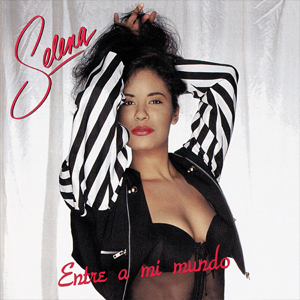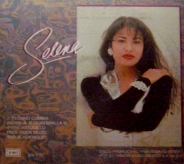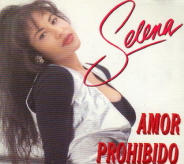
Selena Quintanilla-Pérez, known mononymously as Selena, was an American singer. Referred to as the "Queen of Tejano Music", her contributions to music and fashion made her one of the most celebrated Mexican-American entertainers of the late 20th century. In 2020, Billboard magazine put her in third place on their list of "Greatest Latino Artists of All Time", based on both Latin albums and Latin songs chart. Media outlets called her the "Tejano Madonna" for her clothing choices. She also ranks among the most influential Latin artists of all time and is credited for catapulting the Tejano genre into the mainstream market.

Jose Roberto Pulido Jr., known professionally as Bobby Pulido, is an American singer, songwriter, guitarist, and actor. He is acclaimed for pioneering the dissemination of Tejano music to a youthful audience, subsequently ascending as a teen idol and becoming one of the most influential Tejano recording artists among Mexican-American teenagers.

Amor Prohibido is the fourth studio album by American singer Selena, released on March 22, 1994, by EMI Latin. Having reached a core fan base, the label aimed to broaden her appeal with the next studio release. Finding it challenging to write a follow-up hit after "Como la Flor" (1992), Selena's brother A. B. Quintanilla enlisted the assistance from band members Ricky Vela and Pete Astudillo with writing the album's songs. The resulting album has a more mature sound featuring experimental production that blends diverse musical styles from ranchera to hip-hop music. Amor Prohibido is a Tejano cumbia album modernized with a synthesizer-rich delivery using a minimalist style that was quintessential in early 1990s Tejano music.

Entre a Mi Mundo is the third studio album by American singer Selena, released on May 6, 1992, by EMI Latin. The label endeavored to bolster Selena's popularity within the Latin music market in the United States with this release. Selena's brother, A. B. Quintanilla sustained his role as the singer's producer and, in collaboration with Selena y Los Dinos members Pete Astudillo and Ricky Vela, composed tracks for the album. The ensuing recording encompassed an eclectic array of songs, attributable to the members' diverse backgrounds, which facilitated the modernization of the sundry genres they explored. Entre a Mi Mundo is a Tejano cumbia album that encapsulated Selena's quintessential sound, characterized by engaging tunes harmonized with her distinctive, plaintive vocals and a relaxed, danceable cumbia beat. The album incorporates musical inspirations from power pop, R&B, disco, rock, funk, and synthesized Tejano music.

Live! or Selena Live! is a live album by American Tejano pop singer Selena, which was released on May 4, 1993, by EMI Latin. The album was re-released on September 22, 2002, as being part of the Selena: 20 Years of Music collection; which included spoken liner notes by her family, friends and her former band members Selena y Los Dinos. Live! includes three cumbia-influenced studio tracks, while the rest of the album consists of live versions of previously released songs. The album was recorded during a free concert at the Memorial Coliseum in Corpus Christi, Texas, on February 7, 1993. It was certified gold by the Recording Industry Association of America in its first year, double platinum in 1995, and 8× platinum in 2017.
American singer Selena released eleven studio albums, three live albums, three boxsets, three remix albums, two soundtrack albums, and twenty compilation albums. Credited for elevating a music genre into the mainstream market, Selena remains the best-selling Tejano recording artist in history, selling over 18 million records worldwide. She was named the top-selling Latin artist of the 1990s decade in the US by Billboard magazine.

"No Me Queda Más" is a song by American singer Selena on her fourth studio album, Amor Prohibido. It was released as the third single from the album in October 1994 by EMI Latin. "No Me Queda Más" was written by Ricky Vela, and production was handled by Selena's brother A.B. Quintanilla. A downtempo mariachi and pop ballad, "No Me Queda Más" portrays the ranchera storyline of a woman in agony after the end of a relationship. Its lyrics express an unrequited love, the singer wishing the best for her former lover and his new partner.

"Bidi Bidi Bom Bom" is a song recorded by American Tejano singer Selena. It was released as the second single from her fourth studio album, Amor Prohibido (1994). Originally written about a cheerful fish swimming freely in the ocean, the song's title is an onomatopoeic phrase suggesting the palpitating heartbeat of a person lovestruck by the object of their affection. "Bidi Bidi Bom Bom" was written by Selena and her backup vocalist and dancer Pete Astudillo.
Mazz is a Tejano band originally from Brownsville, Texas. The band was known for their idiosyncratic and innovative form of Tejano cumbia which made them distinguishable among their counterparts. Mazz became one of the most popular Tejano music bands during the genre's 1990s golden age. Mazz won the Latin Grammy Award for Best Tejano Album in 2001, 2002, 2003, 2004, and in 2009, the most wins for a Tejano musician. They landed their first major recording contract with EMI Latin in the early 1990s, before switching to Freddie Records in 1999. Joe Lopez and Jimmy Gonzalez formed Mazz in 1978 before disbanding and creating smaller bands throughout their careers. Gonzalez was known for blending a variety of genres into his basic Tejano sound, a formula he continued to use up until his final release, Porque Todavía te Quiero (2018). Gonzalez was pronounced dead in San Antonio, Texas on June 6, 2018, after suffering from low blood sugar as a result of his diabetes.

"Techno Cumbia" is a song recorded by American singer Selena for her fourth studio album, Amor Prohibido (1994). It was posthumously released as the b-side track to "Dreaming of You" through EMI Latin on August 14, 1995. Techno Cumbia would be put on her fifth and final studio album Dreaming of You (1995) and would be the fourth single for Dreaming Of You. "Techno Cumbia" was written by Pete Astudillo and co-written and produced by Selena's brother-producer A.B. Quintanilla. The song is a dance-pop and tecnocumbia recording with influences of dancehall, rap, Latin dance, and club music. Lyrically, Selena calls on people to dance her new style the "techno cumbia" and calls out those who cannot dance.

"Amor Prohibido" is the title song of American Tejano singer Selena's fourth studio album of the same name (1994). Released as the lead single through EMI Latin on April 13, 1994, it was written by Selena, her brother and music producer A. B. Quintanilla, and her band's backup vocalist Pete Astudillo. A popular interpretation compares it to Romeo and Juliet.
Regional Mexican Albums is a genre-specific record chart published weekly by Billboard magazine in the United States. The chart was established in June 1985 and originally listed the top twenty-five best-selling albums of mariachi, tejano, norteño, and grupero, all subgenres of regional Mexican music. The genre is considered by musicologists as "the biggest-selling Latin music genre in the United States", and represented the fastest-growing Latin genre in the United States after tejano music entered the mainstream market during its 1990s golden age.

"Baila Esta Cumbia" is a song recorded by American Tejano singer Selena for her second studio album, Ven Conmigo (1990). It was released as the second single by EMI Latin on August 28, 1990, behind "Ya Ves". It was composed by her brother–producer A.B. Quintanilla, and Selena y Los Dinos backup dancer, Pete Astudillo. The recording is an up-tempo Mexican cumbia song. It was well received by music critics who enjoyed its cumbia-feel and rhythm.
The Tejano Music Award for Female Vocalist of the Year is an honor presented to female Tejano music recording artists. The Tejano Music Awards, first bestowed in 1981, was established to recognize the most talented performers of the genre—a subcategory of regional Mexican music, with roots in the music of early European settlers in Texas. The awards are presented by the Texas Talent Musicians Association (TTMA), to "promote excellence in the Tejano music industry" using the popular vote method to select the winner of the female vocalist of the year. Historically, female musicians fared less favorably in the male-dominated genre and were seen as inferior to their male counterparts. The award was established by Rick Trevino, a male Tejano performer, who founded the Awards in 1981.

Latin music is a term used by the music industry as a catch-all category for various styles of music from Ibero-America, which encompasses Latin America, Spain, Portugal, and the Latino population in Canada and the United States, as well as music that is sung in either Spanish and/or Portuguese.
The Tejano Music Award for Male Entertainer of the Year is an honor presented annually by the Texas Talent Musicians Association (TTMA). The Tejano Music Awards were first awarded in 1981 and was established to recognize the most talented performers of Tejano music—a subgenre of regional Mexican music. The nominees were originally selected by a voting poll conducted among program directors and disc jockeys of Spanish-language radio stations in Texas. Originally, winners were chosen by Tejano radio station KIWW listeners, and later by fans of Tejano musicians in the Southwest of the United States. Winners are selected through a survey of 50,000 Texas households with Hispanic surnames. By 1987, the award ceremony was broadcast through 32 radio stations and 25 local television channels in Texas, New Mexico, Arkansas, Oklahoma and Louisiana. The awards ceremony were originally held at the Henry B. Gonzalez Convention Center, then to the San Antonio Convention Center until 1994, and the Alamodome until 1999. As of 2015, the ceremony is held annually at the Tobin Center for the Performing Arts in San Antonio, Texas.
The Tejano Music Award for Male Entertainer of the Year is an honor presented annually by the Texas Talent Musicians Association (TTMA). The Tejano Music Awards were first awarded in 1981 and was established to recognize the most talented performers of Tejano music—a subgenre of regional Mexican music. The nominees were originally selected by a voting poll conducted among program directors and disc jockeys of Spanish-language radio stations in Texas. Originally, winners were chosen by Tejano radio station KIWW listeners, and later by fans of Tejano musicians in the Southwest of the United States. Winners are selected through a survey of 50,000 Texas households with Hispanic surnames. By 1987, the award ceremony was broadcast through 32 radio stations and 25 local television channels in Texas, New Mexico, Arkansas, Oklahoma and Louisiana. The awards ceremony were originally held at the Henry B. Gonzalez Convention Center, then to the San Antonio Convention Center until 1994, and the Alamodome until 1999. As of 2015, the ceremony is held annually at the Tobin Center for the Performing Arts in San Antonio, Texas.
José Roberto Pulido, known as Roberto "El Primo" Pulido, is an American musician whose career spans five decades. Pulido has been recognized as a Tejano music pioneer for his introduction of the accordion and saxophone into his music which "helped bridged the traditional conjunto and the modern Tejano camps" in the mid-1970s. Pulido is the father of Tejano musicians Alma Pulido and Bobby Pulido.

This article includes an overview of trends in Latin music in the 1990s, namely in Ibero-America. This includes the rise and fall of various subgenres in Latin music from 1990 to 1999.
La Diferenzia was an American Tejano music septet group based in San Antonio, Texas. Led by Mexican singer-songwriter Ricardo Castillon, its members included Mexican songwriter Miguel Spindola, saxophonist and keyboardist Raul Arnold, bajo sexto player Omar Cardenas, accordionist Simon Arausa, guitarist Jesse Moya, and Jose Luis Benavides on the drums. The group chose "Diferenzia" to stand out from other Tejano bands and wanted to offer a variety of musical styles. Castillon wanted to provide listeners with Tejano, mariachi, merengue, cumbia, and ballads. Ricardo and his brother, Ramiro Castillon, started La Diferenzia, recording under Manny Guerra's label in the late 1980s. Following Ramiro's death during a car accident in 1991, the group disbanded.











